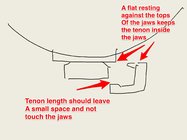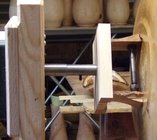Greetings and salutations from north Oregon,
my question today is about a piece of mungo pine that I am turning. It was cut last month and is the first piece of wood that I have turned that was so wet that I could feel spray on my arm! The piece is 5 by 5 inches and I am getting close to the point of remounting it in my chuck. The drive center that came with the ‘smith is doing the job getting it to this place. My question is what is the best way to remount it, a tenon or a recess?
Despite the shaking the old ‘smith is handling this pretty well, and I did not even pull out the speed reducer!
Best, Spike
my question today is about a piece of mungo pine that I am turning. It was cut last month and is the first piece of wood that I have turned that was so wet that I could feel spray on my arm! The piece is 5 by 5 inches and I am getting close to the point of remounting it in my chuck. The drive center that came with the ‘smith is doing the job getting it to this place. My question is what is the best way to remount it, a tenon or a recess?
Despite the shaking the old ‘smith is handling this pretty well, and I did not even pull out the speed reducer!
Best, Spike


